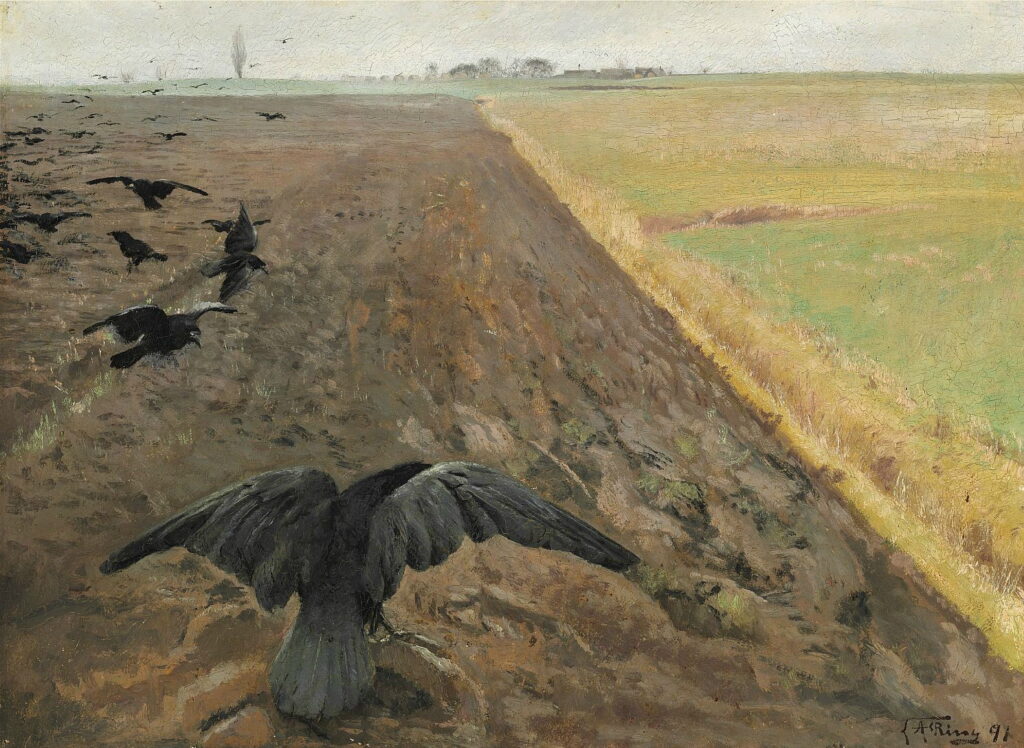A to Z of Landscapes: Earth

Today we’ve reached E in this alphabetic survey of landscape painting, which can only stand for Earth. In one sense, this is what landscapes are all about, and the earth beneath us determines the landscapes to paint. It’s also one of the four classical elements, standing along with air, water and fire, and means that material underlying all the vegetation on which we rely.
I start with some general views that are characteristically earthy.
Camille Pissarro (1830–1903), Côte de Jalais, Pontoise (1867), oil on canvas, 87 x 114.9 cm, Metropolitan Museum of Art, New York, NY. Wikimedia Commons.
Camille Pissarro’s Côte de Jalais, Pontoise from 1867 shows the hill of Les Jalais at l’Hermitage, viewed from the Chemin des Mathurins in Pontoise, where the artist and his family lived at the time. This was exhibited at the Salon in 1868, where it was well received by Zola and several other critics.
Anna Althea Hills (1882-1930), After the Storm, Hemet, California (1922), oil on panel, 50.8 x 61 cm, Laguna Art Museum, Laguna Beach, CA. The Athenaeum.
Passing over to the west of the USA, After the Storm, Hemet, California is one of Anna Althea Hills’ finished paintings, probably based on quick plein air sketches. Hemet, and its conjoining city of San Jacinto, are far inland, in the San Jacinto Valley, well to the northeast of her studio in Laguna Beach.
Paul Nash (1892–1946), Berkshire Downs (1922), oil on canvas, 76 x 55.5 cm, Scottish National Gallery of Modern Art, Edinburgh, Scotland. The Athenaeum.
Paul Nash’s autumnal view of the Berkshire Downs was probably painted when he was visiting his father in his home at Iver, in the chalk downland of Berkshire, to the north-west of London.
Julian Onderdonk (1882–1922), Fall Landscape (date not known), oil on board, 22.9 x 30.5 cm, location not known. Wikimedia Commons.
Julian Onderdonk’s undated Fall Landscape shows countryside near the artist’s home in San Antonio, Texas.
Even when trees and vegetation partly obscure the landscape, that earth is ever present.
Enrique Simonet Lombardo (1866–1927), Otoño en la Dehesa (Autumn in the Dehesa) (1918), oil on canvas, 58 x 43 cm, location not known. Wikimedia Commons.
This canvas by the Spanish artist Enrique Simonet shows a very Spanish motif: the Dehesa, a type of landscape characteristic of southern and central Spain and Portugal, where it’s known as montado. This is a traditional mixed, multifunctional environment providing grazing for cattle, goats, sheep and pigs, mixed trees centred on oaks, and support for many endangered species such as the Iberian lynx and Spanish imperial eagle.
This is an earth that humans have been transforming ever since we ceased being hunter-gatherers. To become farmers, one of the first skills we had to learn was how to plough the earth.
Rosa Bonheur (1822–1899), Ploughing in Nevers (1849), oil on canvas, 134 x 260 cm, Musée d’Orsay, Paris. Wikimedia Commons.
Teams of oxen drew ploughs through the soil, as shown in Rosa Bonheur’s Ploughing in Nevers, her first successful painting in 1849. Faithful depiction of the teams of oxen is demanding on anatomical knowledge, and here incorporates a fine landscape with rich colours and textures.
Eugène Burnand (1850–1921), Ploughing in the Jorat (1916), oil on canvas, 270 x 620 cm, location not known. Wikimedia Commons.
In 1915 Eugène Burnand painted his last major work, Ploughing in the Jorat, but his first version was destroyed by fire. He completed this second version the following year. This wide-screen pastoral landscape contains a patchwork of villages and farmland between forested hills, near where the artist lived.
Giovanni Segantini (1858–1899), Ploughing (1890), oil on canvas, 117.6 x 227 cm, Neue Pinakothek, Munich, Germany. Image © Ad Meskens, via Wikimedia Commons.
Giovanni Segantini’s second and Divisionist version of Ploughing was painted in 1890, and shows a location just to the south-east of the village of Savognin, in Switzerland, where the artist lived.
Grant Wood (1891–1942), Fall Plowing (1931), oil, dimensions and location not known. Wikimedia Commons.
Grant Wood’s Fall Plowing (1931) shows a recently-developed walking plough with a steel ploughshare, that had become an important advance in cultivating the prairie in Iowa.
Grant Wood (1891–1942), Spring Turning (1936), oil on Masonite, 46.4 x 101.9 cm, Reynolda House Museum of American Art, Winston-Salem, NC. Wikimedia Commons.
Wood’s Spring Turning from 1936 is a high aerial view of seemingly endless countryside being ploughed using a pair of horses, during the Spring.
While cultivating the earth, we also travel over its surface on earth tracks.
Rosa Bonheur (1822–1899), Return from the Fields (1854), oil on canvas, 65 x 81 cm, location not known. Wikimedia Commons.
Rosa Bonheur painted two heavily laden carts with their working horses in Return from the Fields in 1854, a work then exhibited at the Goupil Gallery in London.
Those ploughed fields are often left as bare earth through the winter, ready to bear the following year’s crops.
Camille Pissarro (1830-1903), Hoar Frost at Ennery (1873), oil on canvas, 65 x 93 cm, Musée d’Orsay, Paris. WikiArt.
One painting that stands out from Camille Pissarro’s prodigious output when he lived in Louveciennes and Pontoise is Hoar Frost at Ennery from 1873. This was exhibited at the First Impressionist Exhibition the following year, bought that autumn by Faure, and now graces the Musée d’Orsay in Paris.
Sir George Clausen (1852–1944), A Frosty March Morning (1904), oil on canvas, 63.5 x 76.2 cm, The Tate Gallery (Presented by C.N. Luxmoore 1929), London. Photographic Rights © Tate 2016, CC-BY-NC-ND 3.0 (Unported), http://www.tate.org.uk/art/artworks/clausen-a-frosty-march-morning-n04485
Thirty years later, the British Impressionist Sir George Clausen painted similar themes, including A Frosty March Morning (1904), sometimes known as The Allotment Garden, Winter.
Laurits Andersen Ring (1854–1933), Rooks on Plough Furrows (1891), oil on canvas, 56 x 75 cm, location not known. Wikimedia Commons.
Despite its fecundity, temporarily barren earth following ploughing is empty and bleak, as seen in Laurits Andersen Ring’s Rooks on Plough Furrows from 1891. This was probably painted among the flat grain fields close to Odense, or in the south of Sjæland (Zealand), in Denmark. A few months later that earth would bring forth the harvest.



